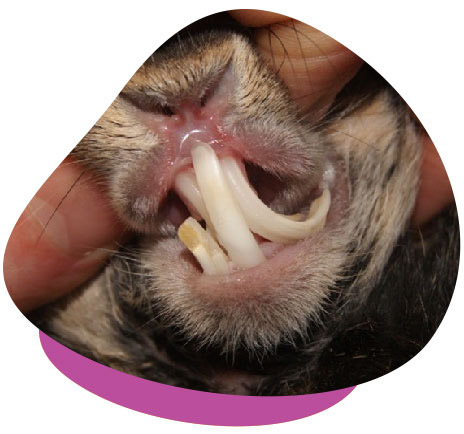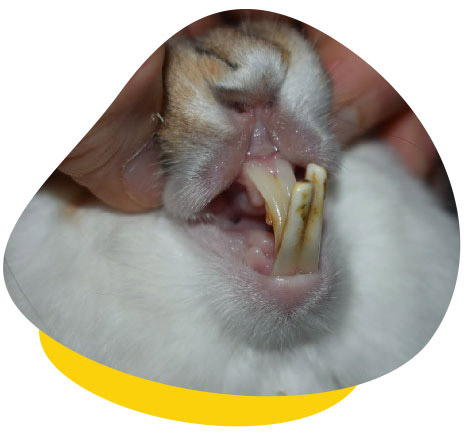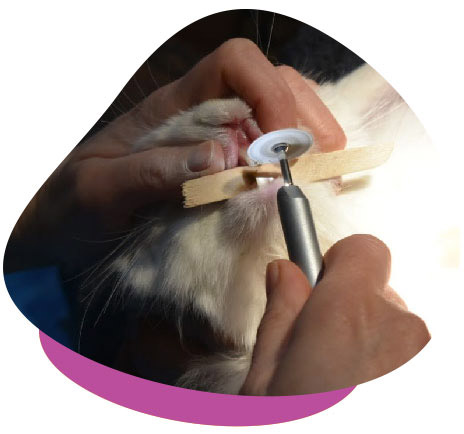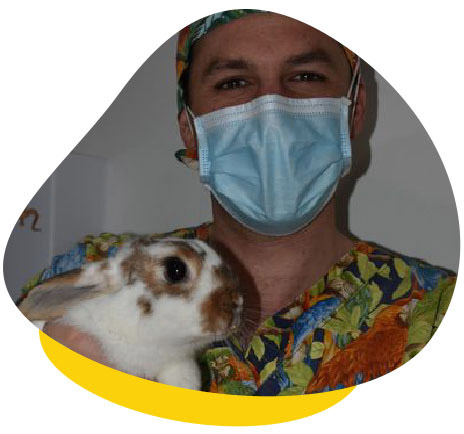Incisor malocclusion is a dental condition where the incisors don’t line up correctly. Consequently, the normal process of chewing doesn’t wear down the rabbit’s teeth. It is commonly seen in rabbits that have a short face, such as mini-lops or Netherland dwarfs.

Which Teeth Are the Incisor Teeth?
Rabbits have six teeth at the front of their mouth and twenty-two ‘cheek’ teeth at the back of the mouth. Their front teeth are further broken down into the four main ones (two upper and two lower) called incisors, and the two small thin teeth behind the upper incisors referred to as peg teeth.
All rabbit teeth grow continuously throughout their lives, and the incisors generally continue to grow at around 3-4 mm a week, therefore, it is important to keep a close eye on your rabbits’ teeth. If you notice signs of misalignment or overgrowth, get in touch with your veterinary team.
How Does Incisor Malocclusion Occur?
1. Trauma
Falls or wire chewing can damage the incisors and change the direction in which they grow.
2. Primary or Congenital Malocclusion
This is the most common cause. Although mainly occurring in young rabbits, it may take years for a problem to show itself. These rabbits are born with teeth not growing evenly. Usually, the back “cheek” teeth are normal. A poor diet can slowly exacerbate a low-grade issue.
3. Secondary Malocclusion
In older rabbit’s, cheek teeth problems can cause poor wear on the incisors, which can then change the direction of their growth and lead to malocclusion.

What Are the Treatment Options?
There are two main treatment options for incisor malocclusion, and the recommended course of action depends on the individual case, so it is best to consult with your rabbit vet about which option would be best.

Treatment Option 1
Regular trimming at the vets with a specialised dental burr is often one treatment option. This generally is needed every 2-8 weeks for the rest of your rabbit’s life. The cost of this procedure is cheaper than removal initially but can add up over time.
In many cases, the procedure can be performed with your rabbit being awake (i.e. no general anaesthesia is needed). You must never ‘clip’ or ‘cut’ rabbits teeth with nail clippers or scissors as this can lead to tooth fractures and increase the risk of an abscess forming.
Treatment Option 2
The more permanent option involves the removal of all six front teeth. It is a big surgery, and we do not usually combine this with other surgeries due to the time spent under anaesthetic. Before the surgery, your rabbit is given a sedative and pain relief to ensure they are as comfortable as possible.
A catheter is then placed in a vein, and they are connected to an intravenous drip. Once the teeth have been removed, your rabbit will need to have their vegetables grated or finely chopped so that they can eat them okay, as they will no longer be able to bite chunks of food off whole vegetables.
It is important that prior to the surgery, the teeth are not left too long. This may result in fractures below the gum line in the bone. These fractures can sometimes prevent us from removing all the tooth, and they can grow back, meaning another surgery may be needed.

After Dental Surgery Care
After the surgery, your rabbit needs to have pain relief medication for the next 3-7 days. They also need to be kept inside for at least 7-10 days and not placed behind wire as some rabbits may rub their sockets on the wire causing infection and delaying healing.
If you are concerned about your rabbit’s teeth, please don’t hesitate to contact us or book an appointment online for a dental check.

